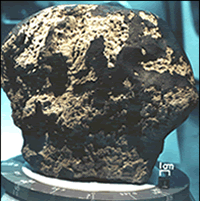Antarctic Meteorites

LAP 02205, a Lunar basalt collected from La Paz icefield.
The US funded collection and curation of Antarctic meteorites, or the US Antarctic Meteorite program, is a cooperative effort among NASA, the National Science Foundation (NSF) and ANSMET, and the Smithsonian Institution (SI). The NSF has decades of experience exploring this harsh environment, and provides support for field research and collection. NASA and the Smithsonian Institution are, experts in curation of lunar samples and geologic specimens, respectively, and provide for the classification, storage and distribution of Antarctic meteorites (Cassidy, 2003; Cassidy et al., 1992; Harvey, 2003; Graham and Annexstad, 1989; McCoy et al., 2008; Marvin and Mason, 1980; Allen et al., 2011; Righter et al. 2015; Corrigan et al., 2015; Harvey et al., 2015). As of 2016, the total number of samples recovered is ~22,000, and JSC curators have sent over 19,000 meteorite samples to roughly 600 scientists worldwide. The collection is among the largest in the world, and features samples from the Moon, Mars, and asteroids (Fig. 1).
Antarctic meteorite EET 79001 - an 8 kg (17 lb) martian meteorite. Dark fusion crust, created during high speed entry through Earth's atmosphere, covers most of the exterior, and the light colored basaltic interior is visible where the fusion crust has broken off. Photo taken in the Meteorite Processing Lab at NASA-JSC.
References
Allen, C.C, Allton, J.A, Lofgren, G.E., Righter, K., and Zolesnky, M.E. (2011) Curating NASA's extraterrestrial samples - Past, present, and future. Chemie der Erde 71, 1-20.
Cassidy, W.A. (2003) Meteorite, Ice, and Antarctica: a personal account. Cambridge University Press, Cambridge, UK, 349 pp.
Cassidy, W., Harvey, R.P., Schutt, J., Delisle, G., Yanai, K. (1992) The meteorite collection sites of Antarctica. Meteoritics 27, 490-525.
Corrigan, C.M., Welzenbach, L.C., McBride, K.M., Righter, K., Satterwhite, C.E., Harvey, R.P., McCoy, T.J., and Singerling, S.A. (2015) A Statistical Look at the US Antarctic meteorite collection. In Righter, K., Corrigan C.M., Harvey, R.P., and McCoy, T.J. eds., 35 seasons of U.S. Antarctic Meteorites: A pictorial guide to the Collection. AGU Special Publication 68, 173-187.
Graham, A.L. and Annexstad, J.O. (1989) Antarctic Meteorites. Antarctic Science 1, 3-14.
Harvey, R.P. (2003) The origin and significance of Antarctic meteorites. Chemie der Erde - Geochemistry 63, 93-147.
Harvey, R.P., Schutt, J., and Karner, J. (2015) Fieldwork methods of the US Antarctic Search for Meteorites Program. In Righter, K., Corrigan C.M., Harvey, R.P., and McCoy, T.J. eds., 35 seasons of U.S. Antarctic Meteorites: A pictorial guide to the Collection. AGU Special Publication 68, 23-42.
McCoy, T.J., Welzenbach, L.C., Corrigan, C.M. (2008) Antarctic meteorites: exploring the solar system from the Ice. In: Smithsonian at the Poles , pp. 387-394.
Marvin, U.B. and Mason, B. (eds.) (1980) Catalog of Antarctic Meteorites, 1977-1978. Smithsonian Contributions to the Earth Sciences No. 23, 50 pp.
Righter, K., Corrigan, C. M., McCoy, T. J. and Harvey, R. P. (eds) (2014) 35 Seasons of U.S. Antarctic Meteorites (1976-2010): A Pictorial Guide to the Collection, John Wiley & Sons, Inc, Hoboken, NJ, 336 pp; doi: 10.1002/9781118798478.fmatter

